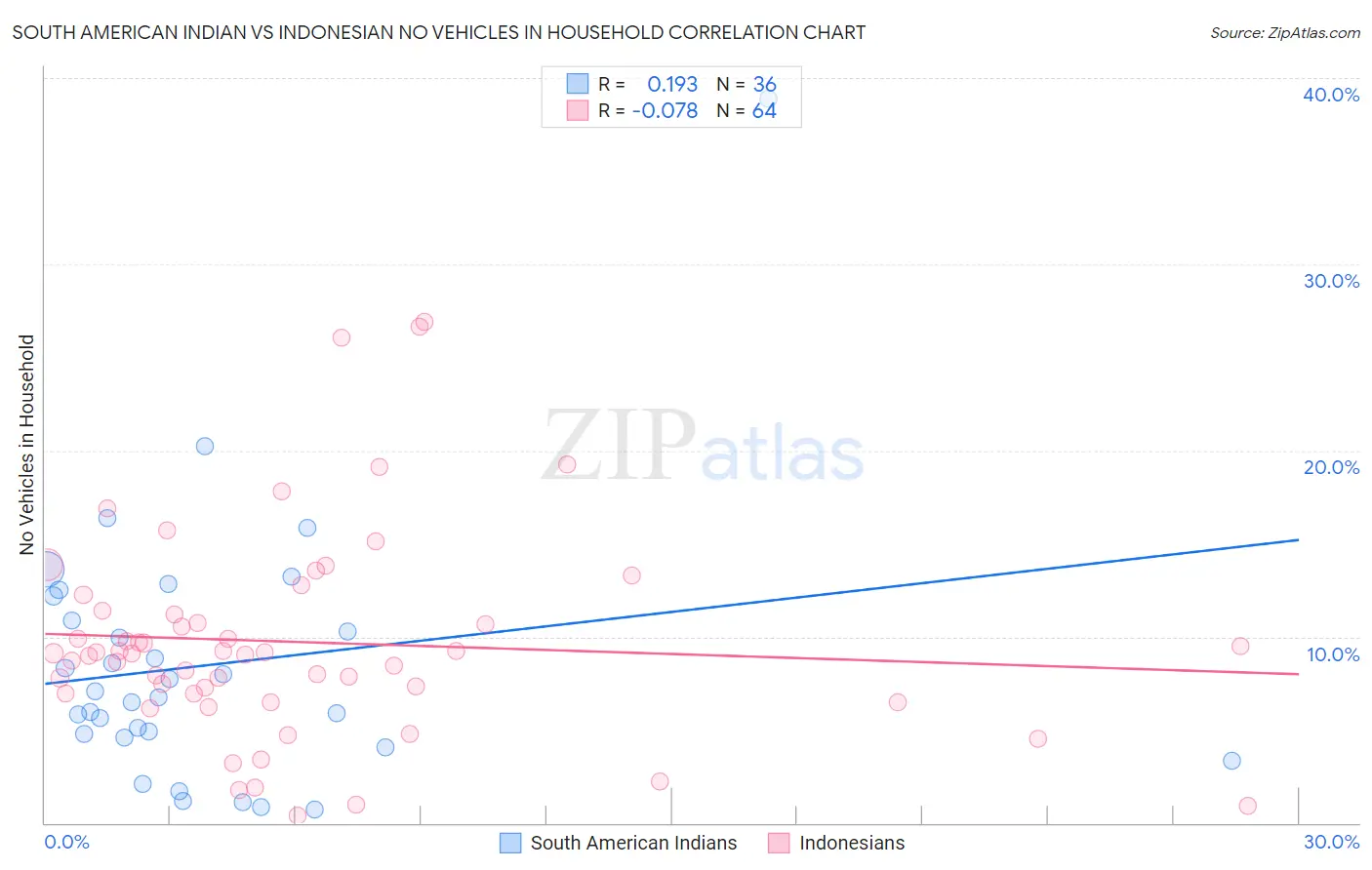South American Indian vs Indonesian No Vehicles in Household
COMPARE
South American Indian
Indonesian
No Vehicles in Household
No Vehicles in Household Comparison
South American Indians
Indonesians
12.1%
NO VEHICLES IN HOUSEHOLD
0.9/ 100
METRIC RATING
258th/ 347
METRIC RANK
10.3%
NO VEHICLES IN HOUSEHOLD
56.7/ 100
METRIC RATING
168th/ 347
METRIC RANK
South American Indian vs Indonesian No Vehicles in Household Correlation Chart
The statistical analysis conducted on geographies consisting of 164,483,116 people shows a poor positive correlation between the proportion of South American Indians and percentage of households with no vehicle available in the United States with a correlation coefficient (R) of 0.193 and weighted average of 12.1%. Similarly, the statistical analysis conducted on geographies consisting of 162,572,047 people shows a slight negative correlation between the proportion of Indonesians and percentage of households with no vehicle available in the United States with a correlation coefficient (R) of -0.078 and weighted average of 10.3%, a difference of 17.0%.

No Vehicles in Household Correlation Summary
| Measurement | South American Indian | Indonesian |
| Minimum | 0.72% | 0.37% |
| Maximum | 38.9% | 26.9% |
| Range | 38.2% | 26.5% |
| Mean | 8.5% | 9.7% |
| Median | 6.9% | 9.1% |
| Interquartile 25% (IQ1) | 4.7% | 7.0% |
| Interquartile 75% (IQ3) | 11.5% | 11.3% |
| Interquartile Range (IQR) | 6.9% | 4.3% |
| Standard Deviation (Sample) | 7.0% | 5.6% |
| Standard Deviation (Population) | 6.9% | 5.6% |
Similar Demographics by No Vehicles in Household
Demographics Similar to South American Indians by No Vehicles in Household
In terms of no vehicles in household, the demographic groups most similar to South American Indians are Nigerian (12.1%, a difference of 0.020%), Immigrants from Latvia (12.1%, a difference of 0.24%), Liberian (12.0%, a difference of 0.76%), Macedonian (12.2%, a difference of 0.80%), and Honduran (12.0%, a difference of 0.81%).
| Demographics | Rating | Rank | No Vehicles in Household |
| Blacks/African Americans | 1.6 /100 | #251 | Tragic 11.9% |
| Immigrants | Serbia | 1.5 /100 | #252 | Tragic 11.9% |
| Egyptians | 1.4 /100 | #253 | Tragic 11.9% |
| Immigrants | Uruguay | 1.3 /100 | #254 | Tragic 11.9% |
| Hondurans | 1.2 /100 | #255 | Tragic 12.0% |
| Liberians | 1.2 /100 | #256 | Tragic 12.0% |
| Nigerians | 0.9 /100 | #257 | Tragic 12.1% |
| South American Indians | 0.9 /100 | #258 | Tragic 12.1% |
| Immigrants | Latvia | 0.8 /100 | #259 | Tragic 12.1% |
| Macedonians | 0.7 /100 | #260 | Tragic 12.2% |
| Sub-Saharan Africans | 0.6 /100 | #261 | Tragic 12.2% |
| Immigrants | Liberia | 0.6 /100 | #262 | Tragic 12.2% |
| Immigrants | Egypt | 0.6 /100 | #263 | Tragic 12.2% |
| Immigrants | Switzerland | 0.5 /100 | #264 | Tragic 12.3% |
| Africans | 0.4 /100 | #265 | Tragic 12.3% |
Demographics Similar to Indonesians by No Vehicles in Household
In terms of no vehicles in household, the demographic groups most similar to Indonesians are Lumbee (10.3%, a difference of 0.27%), Immigrants from Saudi Arabia (10.3%, a difference of 0.29%), Immigrants from Latin America (10.4%, a difference of 0.48%), Immigrants from Costa Rica (10.3%, a difference of 0.54%), and Hmong (10.4%, a difference of 0.55%).
| Demographics | Rating | Rank | No Vehicles in Household |
| New Zealanders | 65.1 /100 | #161 | Good 10.2% |
| Immigrants | Austria | 64.4 /100 | #162 | Good 10.2% |
| Immigrants | Cambodia | 63.7 /100 | #163 | Good 10.2% |
| South Africans | 61.1 /100 | #164 | Good 10.2% |
| Comanche | 60.8 /100 | #165 | Good 10.2% |
| Immigrants | Costa Rica | 60.5 /100 | #166 | Good 10.3% |
| Immigrants | Saudi Arabia | 58.8 /100 | #167 | Average 10.3% |
| Indonesians | 56.7 /100 | #168 | Average 10.3% |
| Lumbee | 54.7 /100 | #169 | Average 10.3% |
| Immigrants | Latin America | 53.2 /100 | #170 | Average 10.4% |
| Hmong | 52.7 /100 | #171 | Average 10.4% |
| Brazilians | 51.7 /100 | #172 | Average 10.4% |
| Filipinos | 50.1 /100 | #173 | Average 10.4% |
| Immigrants | Sudan | 50.0 /100 | #174 | Average 10.4% |
| Immigrants | Burma/Myanmar | 49.1 /100 | #175 | Average 10.4% |